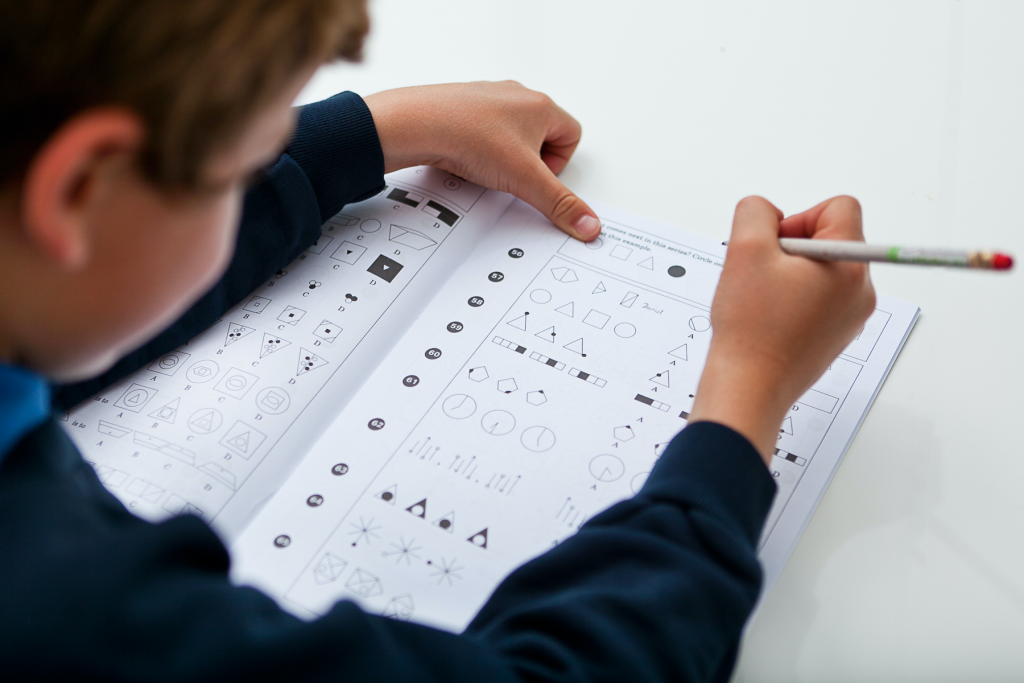Verbal and non-verbal reasoning are key components of many entrance exams, including the 11+ exams. They assess a child’s ability to think logically, analyse patterns, and solve problems—skills crucial for academic success.
Essentially, verbal reasoning works with words and non-verbal reasoning works with pictures and diagrams. To elaborate, the 11+ exams feature problem-solving using pictures and diagrams for the non-verbal reasoning section. It tests the ability to analyse visual information and solve problems based on visual reasoning. Verbal Reasoning requires children to problem solve using words and letters, such as cracking codes and thinking about text.
11+ Exams: Verbal Reasoning
Verbal reasoning evaluates language and comprehension skills. It involves tasks like analogies, odd-one-out questions, and sequencing words. These questions require students to apply their understanding of vocabulary, grammar, and logical connections to solve problems.
For instance,
– Analogies: “Dog is to Bark as Cat is to ____.”
– Word Groups: Identify the word that doesn’t fit (e.g., Banana, Apple, Pear, Carrot).
Verbal reasoning helps assess how well students can use language to interpret information and make deductions, which are essential for academic progress and everyday tasks.
11+ Exams: Non-Verbal Reasoning
Non-verbal reasoning involves visual and spatial problem-solving. Students are tested on their ability to recognize shapes, patterns, and sequences without relying on language. This section typically includes tasks such as finding the next shape in a series, identifying a missing piece in a puzzle, or spotting the odd one out among visual figures.
For instance,
– Sequences: Which shape comes next in this series?
– Odd-One-Out: Which image does not belong in the set?
Non-verbal reasoning tests enhance students’ ability to think abstractly and solve problems based on pattern recognition, which can improve skills in subjects like maths and science.
Both types of reasoning focus on critical thinking and problem-solving skills, making them an excellent measure of a child’s potential beyond the scope of the traditional curriculum. It evaluates their ability to understand, interpret, and process information, and helps prepare students for the cognitive challenges of higher education and life beyond school.
How to Prepare for the 11+ Exams
Practice papers have been shown to help students become more accustomed to the format of the test and improve their time management abilities. Using sample 11+ exams not only helps students feel less anxious and stressed but also enables them to carefully organise their revision strategy, focusing on developing continuous study habits for a more pleasurable preparation experience. This methodical strategy promotes efficient and rapid answers to questions, building confidence and exam readiness.
Quest for Exams has practice papers, mock exams, and more for student’s to identify themselves with non-verbal and verbal reasoning questions that are common in 11+ exams. Regular practice with sample papers will familiarise students with the question types and time constraints.
Additionally, games and puzzles are a way for students to enhance their non-verbal and verbal reasoning skills. Engaging in puzzles, crosswords, or online reasoning games train the brain to recognize visual sequences, understand spatial relationships, and solve problems abstractly.
Understanding how to approach different question types and manage time effectively for the 11+ exams can boost confidence and performance on exam day. Quest for Exam has time-managed tests and more videos to help master verbal and non-verbal reasoning, students enhance their overall cognitive abilities, setting a strong foundation for future success.


